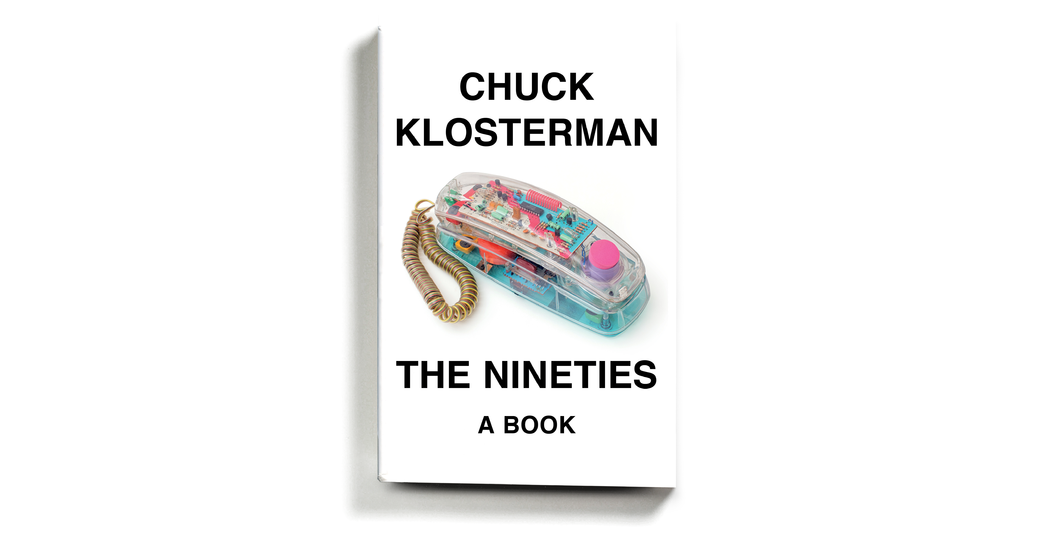They’re baaack.
The catchphrase that long outlived “Poltergeist II,” the forgettable 1986 sequel to the memorable 1982 movie, now (the horror!) applies to the decade that followed, the subject of Chuck Klosterman’s new book, “The Nineties.” Parsing catchphrases and other pop-culture flotsam, he has built a sturdy publishing career.
A prolific essayist, novelist and several other “-ists” (he used to write The Ethicist column for The New York Times), Klosterman is turning his attention not to poltergeists but, yet again, the zeitgeist — specifically to a shrugging, liminal period he believes began in earnest, or in irony, with the release of Nirvana’s album “Nevermind” in September of 1991. This event of rock ‘n’ roll history he compares to a plane representing the noisy ’80s on autopilot crashing into a mountain. (A perhaps injudicious metaphor, considering that Klosterman thinks the ‘90s officially ended with the collapse of the Twin Towers.)
The era has lately been a source of curiosity, its aesthetic mined by digital natives who marvel at the freedom of a world where people partied and presented themselves without being haunted by their online shadows. “Every new generation tends to be intrigued by whatever generation existed 20 years earlier,” Klosterman writes. This particular look back has special romance, since, as he writes mock-portentously, “The internet was coming. The internet was coming. The internet was coming.” But the internet as we know it wasn’t quite there yet.
The 1990s were the twilight of a millennium and a monoculture (such as it was); the last time we (whoever “we” were) seemed to be on the same page: one we could crinkle in our hands. Judging from the way things are going so far in the 21st century, it might have also been the last time Americans could reasonably carve up history into digestible 10-year chunks, a practice that goes back at least as far as the Gay ’90s — the 1890s.
The more recent nineties surely deserve to be memorialized, but for anyone who lived through them, it may feel, as they say in comedy, Too Soon.
Klosterman’s simple subtitle, “A Book,” underscores the erosion of the physical world in the years since. He examines sports, politics, crime and experiments like Biosphere 2, but he is primarily interested in the decade’s arts and diversions, delivered through endangered technology. “Nevermind” was released on records, cassette tapes and compact discs, and later pirated on Napster. Remember telephones that plugged into the wall and the brief, heart-pounding excitement of chasing down mystery callers with *69? The fear of Y2K? How about the fading scrolls spit out by fax machines? Squealing, dial-up modems? VCRs? Klosterman does, with measured wonderment; he admits that the contrast between life then and now can be fairly subtle: “soft differences.”
Now nearly extinct, the video rental store, which this reader recalls viscerally as a depressing pit stop filled with plastic, fluorescence and frustration, is exalted here as a temple of serendipity and erudition, unconstrained by pigeonholing algorithms. The stores birthed maverick film directors like Kevin Smith and Quentin Tarantino, who flouted the studio systems that were churning out prequels like “The Phantom Menace” and the nostalgic spoof “The Brady Bunch Movie” — prototypes for today’s reboot factory.
Movies in the ’90s, a zenith for independent auteurs, were indisputably king, but television, newly recordable and replayable, was our everything, Klosterman argues. And also our nothing. He’s kind of a hedger, answering one self-posed question about the commodification of culture: “(Yes.) (No.) (Sometimes.)” There was supposed “Must See TV,” like “Seinfeld,” the definitive show about nothing, but also expanded hours of bland background programming on VH1 and its ilk. (“Here we are now, entertain us,” Nirvana’s Kurt Cobain bleakly sang.)
Some of the most important public decisions were influenced by live TV performances, like James Stockdale declaring “Who am I? Why am I here?” during the 1992 vice-presidential debates, or Clarence Thomas’s emotional demonstration prevailing over Anita Hill’s cooler testimony during Thomas’s confirmation hearings in 1991. “Anything experienced through the screen of a television becomes a TV show,” Klosterman declares, a little too sweepingly. Is the personal computer really “a television you could talk to, and a television that would listen. A television that knew everything. A television built out of people” — or is it a whole other beast? He’s wrong that Generation Z can’t grasp the concept of “albums”; on the contrary, they have helped drive a recent and robust vinyl revival, and seem fascinated by other tactile phenomena you might have expected to disappear forever, like stickers, Polaroids and, actually, videotapes.
Klosterman is more comfortable rolling around with his own generation, X, with its flannel shirts and fizzy drinks: “the least significant of the canonical demographics,” he writes, by virtue of its small size (indeed, it is often erased entirely in meme wars). “Yet one accolade can be applied with conviction. Among the generations that have yet to go extinct, Generation X remains the least annoying.” Yay?
Douglas Coupland, the man who popularized the label, is still with us, and Klosterman interviews him and several other prominent figures from the ’90s. It’s sobering to be reminded of those who aren’t with us — David Foster Wallace, Elizabeth Wurtzel, Cobain — and how depression, despite the broader relative peace and prosperity of the time, was a hallmark of their output. Overall one is left with a shuddering sense of X’s insignificance, its preoccupation with what more politically motivated successors deem “opulent micro-concerns.” It would be more vulnerable to cancellation if it hadn’t already canceled itself. (Is not X the very symbol of cancellation?)
By declaring his cohort recessive and unannoying at best, writing indifferent lines like “times change, because that’s what times do,” Klosterman cunningly sets a low bar for this project. Does it clear it? Well, yes. No. Sometimes.


























